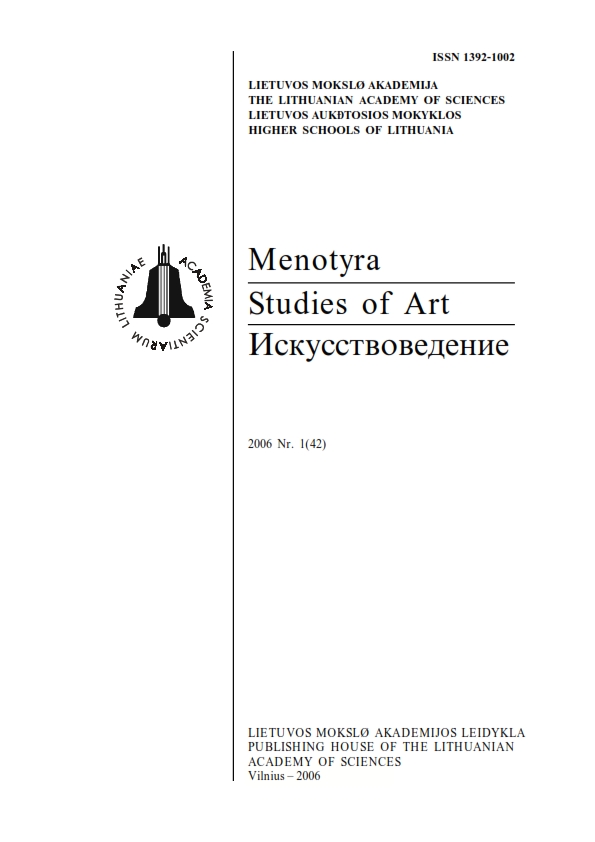Muzikos teorijos raidos aspektai Das Generalbaßzeitalter epochoje
Aspects of music theory development in Das Generalbaßzeitalter epoch
Author(s): Gražina DaunoravičienėSubject(s): Cultural history, Music, 17th Century, 18th Century
Published by: Lietuvos mokslų akademijos leidykla
Summary/Abstract: The thorough bass, basso continuo or Generalbaß tradition is usually treated as a way and method of education to accompany a solo music piece in the 17th–18th centuries. However, having become the most fundamental and best documented theory of baroque music, the thorough bass system reflected the most relevant characteristics of the process of musical art, such as consolidation of the tonal harmonious system, dissemination of instrumental music structures, especially those of ornamentics, unique improvisation of the final piece and the start of the theory of harmony and composition science. This phenomenon of giving the meaning to embedding a partial text of a com-position and adding a piece to the creation in the process of performing (дo- сочинение – M. Katunian’s concept) had a tremendous impact on the further formation of the art of music.The theoretical Das Generalbaßzeitalter (H. Riemann’s concept) reflexion summarizes the intermediate and transitional character of the structural elements and principles of the sys-tem. In treating the thorough bass phenomenon as a two-century-long area of interaction when the past is not yet done with and the future has not yet been created, we distinguish four groups of interaction poles:• the composition that is partially embedded and “added-to” in the process of performing exists thanks to thorough bass. It separates and gets integrated between improvised music and fully embedded music (res facta);• by reflecting on polyphony and instigation of chord function, thorough bass has found its place among practitioners and theoreticians of stylus a cappella ecclesiasticus counterpoint (J. J. Fux) and functional harmony (J. Ph. Rameau, H. Riemann);• thorough bass theory gave a combined treatment to harmony texture integrating all intervals. Thus, it found its place between the epoch of combined concord (Latin cum cordibus, concordis) and the harmonious chord system of major–minor;• by reflecting the transitional character, the thorough bass system found its place between the end of the contrapuntal and harmonious modality epoch and the consolidation of tonal perception.The early examples of “tonal” perception in thorough bass were demonstrated by A. Bruschi, J. Kirnberger, i.e . harmonization examples that lay down the grounds for “octave rules”.At the same time early historical equivalents of “tonal” concept originated and functioned; these were majeur (fr. large), mineur (fr. small); “tuono” (A. Bruschi), mode (J. Ph. Rameau). The concept of tonality originated in 1810 (A. Choron, “ Sommaire de l’histoire de la musique”, 1810). A strong argument for the consolidation of the tonal system was the tonal layout models shaped in quint circle that occurred in the period of Generalbaßzeitalter (J. D. Heinichen, J. Mattheson, G. A. Sorge, etc.) which replaced the quint (Pitagorian) tone progression spirals.Based on the theory and practice of thorough bass, new typologies of various musical art phenomena originated: instrumental (A. Agazzari), texture types (J. F. Daube), vocal chord (Fr. Bianciardi), decoration elements (d’Anglebert, St. Lambert, J. D. Heinichen, J. Mattheson), etc. Thorough bass theory received the same treatment as the basis for composition teaching by F. E. Niedt, J. D. Heinichen, J. Ph. Rameau, J. S. Bach and others. In essence, the intramusical character of the thorough bass phenomenon does not negate the impact of the common cultural and scientific baroque ideas, metaphors and models on the musical art processes mentioned. As claimed by Th. Christensen, philosophical and analytical geometry ideas of R. Descartes, I. Newton’s gravity laws and acoustics mathematics might have been active and subject to musical art. The modernization of the thorough bass system and its extinction were predetermined by the studies of the inner texture of the sound, especially by the discovery of the natural sequence of sounds (M. Mersenne, “Harmonie universelle”, Joseph Sauveur). The majority of original baroque creations with thorough bass notation embedded the original improvisory sound of baroque music, which was lost in our modern age.
Journal: Menotyra
- Issue Year: 2006
- Issue No: 1(42)
- Page Range: 1-9
- Page Count: 9
- Language: Lithuanian

